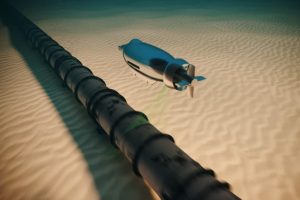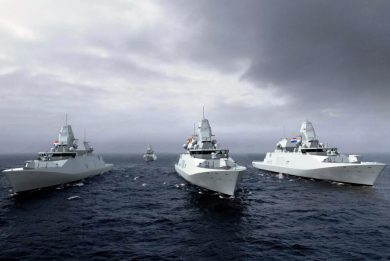UDT 2025 – Euroatlas Greyshark series 2 Foxtrot: a revolution in autonomous underwater systems
Unveiled at the Euronaval 2024 exhibition in Paris and showcased in March 2025 at the UDT conference in Oslo, the Greyshark Series 2 Foxtrot, developed by Euroatlas of Germany, positions itself as a key player in the autonomous underwater vehicles (AUVs) domain. Designed for reconnaissance, surveillance, and the protection of underwater infrastructures, this cutting-edge vehicle combines extended autonomy, advanced technologies, and swarm operation capabilities
The Greyshark Series 2 Foxtrot AUV features a 7.99 metres long hydrodynamically optimised body with a maximum diameter of 1.8 metres, and has a mass of 4.5 tonnes. Made in composite materiel, which reduces to a minimum electromagnetic signature, its shape also gives minimal water disturbance, making it a difficult item to detect, also thanks to the quietness of its electric propulsion system. This is based on a non-permanent magnetic electric ring motor that activates a segmented ring rotor propeller, a cruciform rudder assembly being located behind the propeller. This design allows extreme dive angles and small turning radius, the Greyshark Series 2 Foxtrot being able to dive nearly vertically, according to Euroatlas. Operating speed is 10 knots while maximum speed is declared “over 10 knots”, which should mean that the company does not want to provide that figure. The electric motor is powered by a fuel cell system that ensures a 1,100 NM or five days endurance at operational speed. Reducing speed allows to consistently increase range and endurance, 2,180 NM and one and a half weeks at 8 knots, 5,350 NM and fuve weeks at 6 knots, up to 10,700 NM and 16 weeks creeping at 4 knots. Speed is obviously adapted to the mission.
On the top of the Greyshark Series 2 Foxtrot hull we find at the front the USBL (Ultra-Short BaseLine) acoustic antennas, used for swarm encrypted acoustic communications, while the telescopic antenna system is located at the rear, and ensures LTE (Long Term Evolution) and L-band communications, a GNSS receiving antenna being also part of that suite. Coming to sensors, on the starboard side we find the sidescan synthetic aperture sonar (SAS) that provides ultra high-resolution images.
Under the AUV belly, starting from the bow, we find the front-facing multibeam sonar with two elements, one at the extreme bow and one under the main body, allowing obstacle detection and collision avoidance. These are followed by a radome hosting bottom side acoustic antennas, a depth sensor and a sound velocity sensor. Just behind it comes the wideband multibeam sonar that provides wide-angle high-resolution images of the sea bottom, then comes the doppler velocity sensor with the Phins Subsea integrated inertial navigation system provided by Exail, followed by two imaging cameras and finally by a LIDAR, used for 3D mapping. Two sets of LED clusters ensuring lighting for the cameras are fitted one just behind the SAS and one at the extreme rear. An array of sensors along the AUV hull allow the detection of electromagnetic fields.
All data gathered by the Greyshark sensor suite are fused in order to analyse the situation, the AUV being capable to operate for weeks without human intervention, communicating with base only when a critical event is detected, for example a possible intrusion or an attack against submarine infrastructures such as data cables or pipelines, Artificial Intelligence (AI) allowing to make the AUV as autonomous as possible, ensuring among other functions automatic target recognition. As anticipated, the Greyshark can operate in swarms of up to six AUVs, for example splitting the work among more than one AUV when a wide area must be scanned or monitored, AI allowing to reconfigure the mission should one vehicle fail, or an unexpected event happens; the swarm dynamic leadership can be pre-defined or randomly assigned.
On-board sensors and AI-based algorithms allow the Greyshark to be employed in multiple different missions, ranging from seabed surveillance, to shadow a submarine, inspect objects of interest, and raise an alarm when needed, the AUV being capable to operate both passively or actively in the reconnaissance role, its endurance allowing it to ensure persistent surveillance without the need to commission manpower for the mission, a key feature considering recent events that happened in the sea depths, the Greyshark being able to operate down to 650 metres depth, extendable to 4,000 metres for specific missions.
Autonomy does not mean only the capacity to operate without human intervention; it also means being capable to deploy far from homebase with minimal logistic support. The Greyshark Series 2 Foxtrot can be hosted in a standard 40-foot standard container that can be transported by truck, train, ship and airplane, a second similar container hosting the charging/fuelling infrastructure required to refill the AUV, following a partly automated refuelling process.
Currently the Greyshark Series 2 Foxtrot is undergoing some testing phases, and it is expected to acquire expanded capabilities by 2026, as longer dive durations and enhanced AI integration are performed. The project aligns with European initiatives like SWARMS (Smart and networking underWAter Robots in cooperation MeShes) and SALSA (Smart Adaptive Long- and Short-range Acoustic network) aiming to standardise underwater drone communications. With its combination of stealth, autonomy, and modularity, the Greyshark is poised to become a vital asset for modern navies facing underwater security challenges.
Euroatlas is proposing its AUV for a series of missions; infrastructure protection, such as proactive monitoring of underwater cables and energy platforms; minewarfare, exploiting its autonomous capability to detect and neutralise mines; anti-submarine operations, deceivingenemy submarines via targeted sonar missions using active decoys; and more.
Photo and images courtesy Euroatlas








